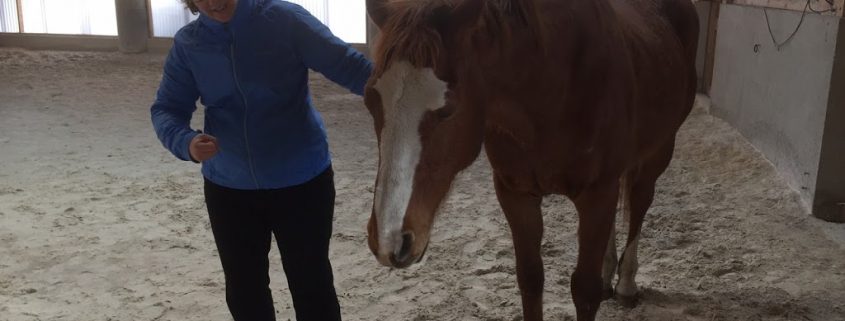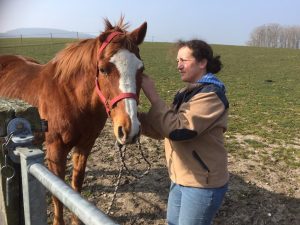Leadership at a Gallop – Equine-Assisted Reflection and Learning
I didn’t wear a helmet, riding boots or a crop when I spent three hours last Sunday morning with Mr. Bean and Frederica- two former polo ponies living on a farm in Bavois, Switzerland. That’s because I didn’t ride them – I spent my time leading them around a chilly arena, slaloming cones and over low barriers (without a rope!), or at least trying to.
This was during one of Sarah Krasker’s equine-assisted learning workshops where she provides individuals ( coming in teams or alone) an opportunity to explore their leadership abilities through experiential learning. You bring your non-verbal communication skills, energy and purpose to bear with giant animals who don’t get office politics or do something because it’s a nice thing to do. If the horse can’t understand your direction, is getting mixed signals, or doesn’t trust you it will simply abandon you for a good, hard, longing look at the rest of the herd in the field out the window.
We were three people, two horses and trainer Sarah for the morning. All of us had picked different aspects of leadership to explore. In our three hours, we worked with the horses twice with reflection and debriefing after each session.
Our goal in the barn arena was simply to get the horse to follow us on its own accord. This seemed unlikely (why should they?) but we were assured if we were giving off the right energy (Sarah called it an “energy bubble”) and signals and made it seem more interesting than anything else going on at the time for the horse it would happen. For that we needed to communicate direction, intention and passion for the task ( walking around the ring or weaving through the cones). Horses being herd animals, we were explained, like to follow a trusted leader. Mustering these forces within you would lead to a satisfying picture of a horse following you around. However, hesitation, a dip in conviction or attention or energy, alternatively means that the horse will just stop in its tracks and look at you patiently, stock still, 900 pounds of immobile weight, with those big beautiful brown eyes. No amount of pushing or cajoling at this stage would get it to move another step.
It took me the first round to connect with the horse and understand more of how strong you have to be to get the horse to follow you. Not muscle strong though; it takes concentrated, ongoing focused energy and mental engagement to get the horse to start and keep moving. My first time I only got a few steps that initially heartened me but quickly showed that the window was more interesting than anything I was offering at the moment.
But the second time, with resolve, a vision in mind about what task completion looked like, a firm but friendly voice and not taking no for an answer, I blocked my energy, gave instructions and turned my back and walked around the ring a couple of times with Frederica following along behind me. Granted, I did start with the rope for the first few steps, but then we unclipped the rope and (to my amazement, although I didn’t let on of course) she still followed me around the ring for a couple of tours. The second time I needed to quality control the slalom by slowing down a little and insisting a little more firmly that she go around all the cones, and she did! (I must confess, at first I thought these just might be very well-trained horses that know their trail and would do it by themselves, but on many occasions, even with the rope, if the leader hesitated or lost their conviction the horse would simply and quite abruptly stop in its tracks. Now that’s feedback!)
It was a thought-provoking morning in the barn and it got me thinking about how I communicate vision, the responsibility for safety that leadership brings (task based as well as emotional), how to make sure that what you are asking, which is out of the ordinary – not business as usual, is more interesting than the familiar other horses or the window. Leadership most often means taking people along to a new place, a new situation, or a new practice.
Working with the horses and Sarah this way provides a great opportunity to get outside the four walls of the office and separate yourself from the day to day. This can give invaluable time for reflection that the barrage of emails and meetings doesn’t always provide for, and a useful experiential learning moment that can move your thinking ( be it at a trot, canter, or run) about your own leadership role while enjoying the warm hay breath of the horses.
(Trainer Sarah Trasker with Mr. Bean)







That is one of the coolest leadership exercises I have ever seen. It's literal in a way that is very thought-provoking.
Hi Alanna, You are absolutely right about that – it is very literal and quite amazing how sensitive the horses are to those silent forces of intention, direction and commitment. They proved it over and over again, giving immediately feedback. Thanks so much for your comment!